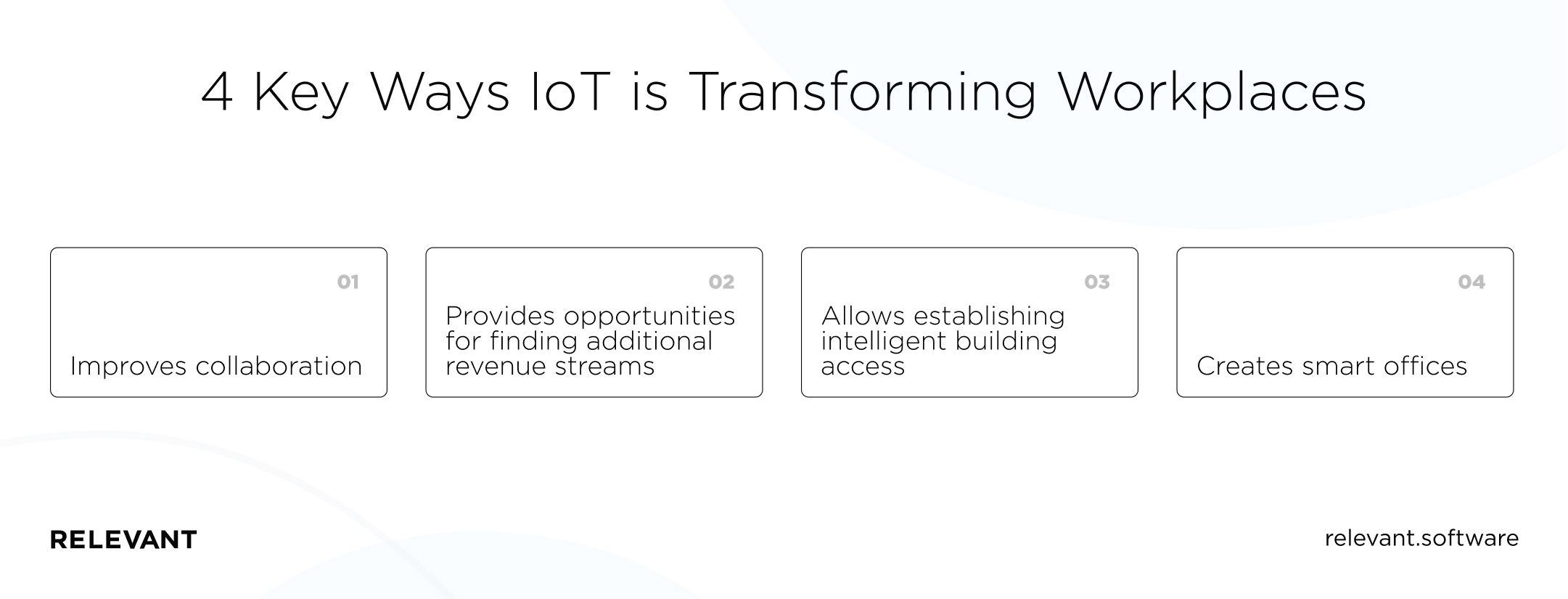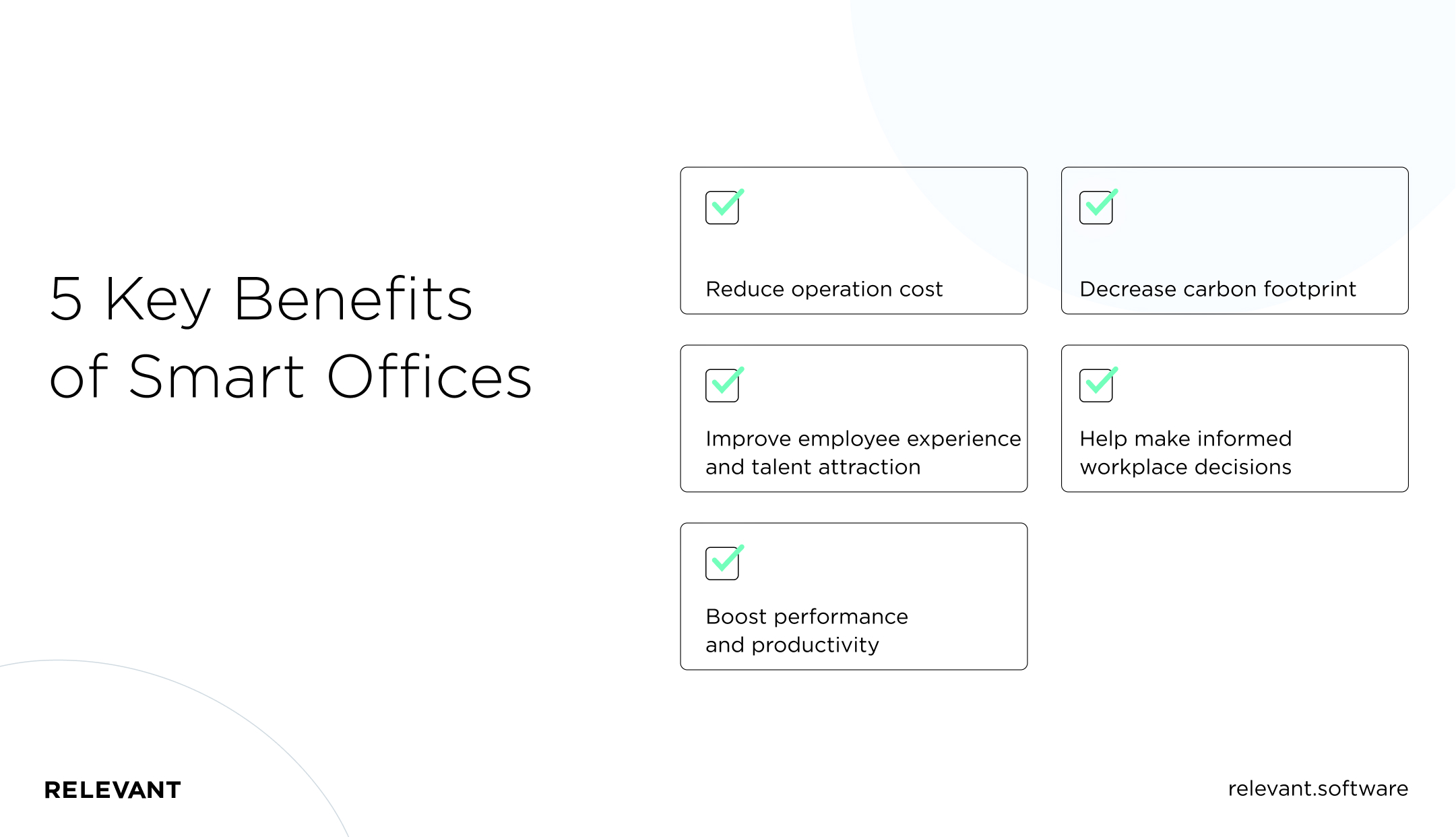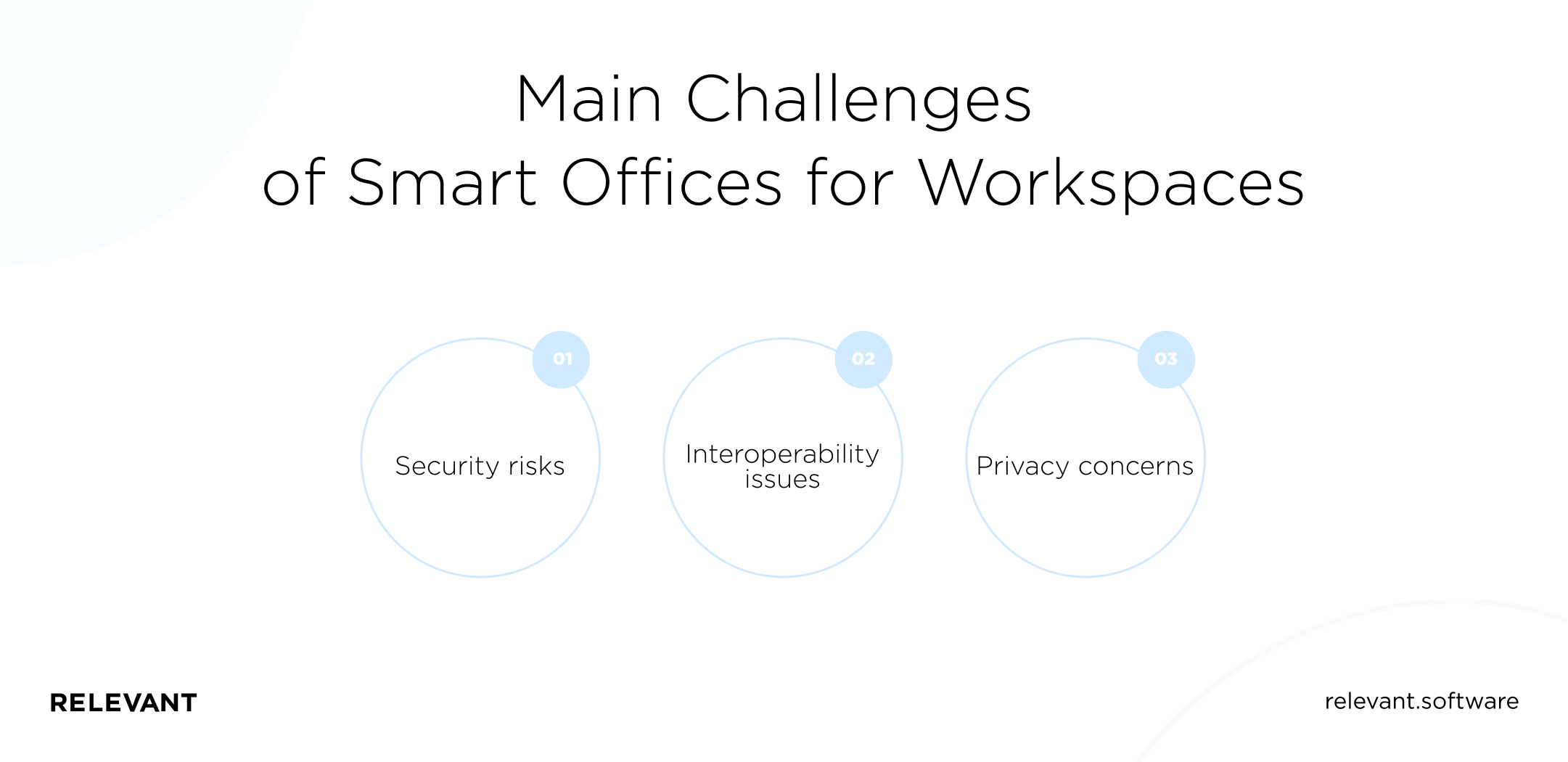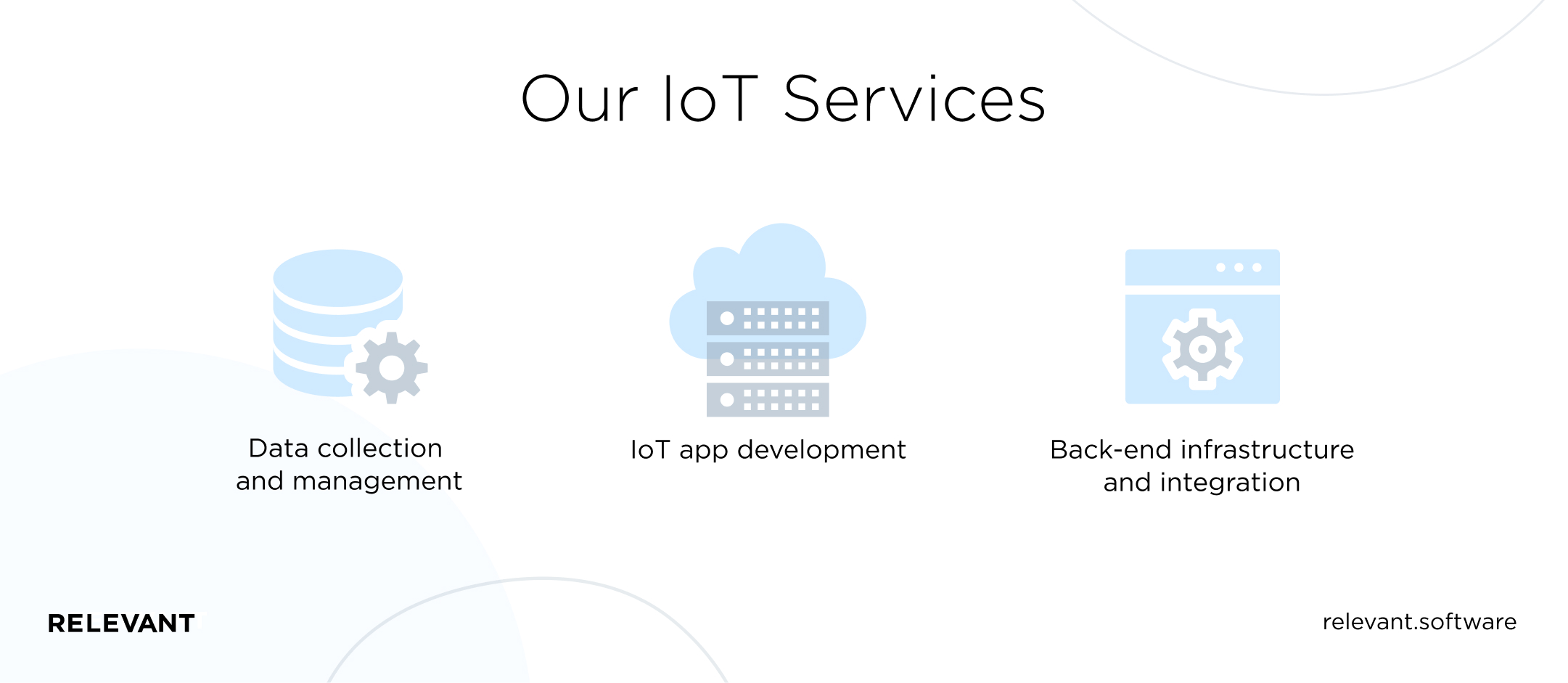IoT in the Workplace: Benefits, Challenges, Applications and Much More
Updated: May 12, 2022
The internet of things has continuously transformed every aspect of life, from how we live to our work and interaction with others. There are smart cups, intelligent lightning, IoT-enabled desks, and just about anything.
This rapid advancement will continue as the total number of IoT devices is set to triple from 8.74 billion in 2020 to over 25.4 billion by 2030. For businesses, this connectivity has given way to the workplace of the future known as smart offices.

We provide companies with senior tech talent and product development expertise to build world-class software. Let's talk about how we can help you.
Contact us
Intelligent offices are leveraging IoT solutions to transform the way of doing business. But what significant benefits does it bring to the workplace? What are the challenges, and how can you use IoT to build a smart office? In this article, we’ll answer these questions and explore if smart offices are a necessity or not.
Table of Contents
How is the Internet of Things transforming workplaces?
Here are some ways IoT is changing how companies manage their work and employees:
Improving collaboration
With changes brought by the Covid-19 pandemic, the hybrid workplace is gaining momentum. This introduces the increased need for better support and collaboration across teams. Standard video conferencing tools fill some of these needs, but advanced workplace IoT technology can go further.
High-end telepresence robots such as Double Robotics’ Double 3 and Ava Robotics’ Ava offer better experiences. Rather than the static video call experience, computers are attached to these robots to give callers more virtual presence over any space.
With this technology, professionals can interact with on-site teams, move around without external guidance, and tour facilities virtually anywhere in the world with just a few clicks. Other immersive technologies like augmented reality provide true-to-life experiences, allowing users to test products or navigate dangerous scenarios from remote locations.
Opportunities for finding additional revenue streams
IoT big data solutions have transformed several ways of doing businesses across industries. Sensors and IoT technologies facilitate the collection of extensive data sets on customer behavior, product performance, etc. For example, wearables like Fitbit, track how we sleep, eat, move around, or exercise. Insights businesses gain from this data help them improve their products or services to meet customers’ needs. Data on business operations can help companies streamline daily and long-term activities.
Beyond improvements, businesses can leverage IoT solutions to identify patterns and new growth opportunities. It may include spotting a new segment for an existing product or entering profitable markets.
Establishing intelligent building access
Access control systems provide a convenient, secure way to access facilities. Connected devices such as locks, card readers, biometric systems are all assigned a unique IP address which is used for communication among themselves. These devices help workers gain entry to buildings or offices without a plastic ID while keeping intruders away.
In most organizations, employees can access a facility through connected IoT mobile apps using a digital ID. The system may track the time and level of access of each user. Any malicious activity triggers an alert in authorized devices, from which you can issue instructions. This ensures the safety of employees and other company assets.
Creating smart offices
Successful implementation of the internet of things at work leads to intelligent offices. These IoT devices in workplaces are helping businesses improve day-to-day operations at workplaces. Examples include Wi-Fi scanners that duplicate and send scanned documents to tablets and computers, smart sensors that adjust temperature and lighting, indoor way finders, etc.

In another section of this article, we’ll discuss more IoT smart office solutions in depth.
Smart Offices: Hype or necessity?
Smart offices are on the rise. According to Grand View Research, Inc., the global smart office market was valued at $18.46 billion in 2016. The sector is projected to grow at a CAGR of 13.2% from 2017, to hit $57.05 billion by 2025. The key drivers of this growth are rapid advancements in technologies like IoT and the increasing need for sustainable practices for IT resources.
A growing number of companies are adopting IoT for smart offices to get the best out of their employees, resources, and cross-organizational collaboration. While these solutions are yet to go mainstream, projections and the benefits businesses derive should prove that it is well on its way to becoming indispensable.

Before we look at some benefits of smart office systems, what is an intelligent office, and how does it work?
What is meant by a Smart Office?
A smart office is a workplace that uses technology to improve workers’ experience, boost efficiency, and improve business performance. The technology includes software, services like cloud-based solutions, and hardware components such as security systems, smart lighting & controls, and HVAC control systems.
How Smart Office works and the role of IoT in it
Often described as the future workplace, the ideology behind smart offices is to promote interaction among connected teams and enable a faster, better way of doing business. Several devices and technologies work together to improve the workplace experience. Like with most digital transformations, IoT facilitates the process.
A smart office system using IoT technology and sensors can exchange data with connected devices. With this data, companies can adjust the work environment, enhance collaboration or identify cost-saving opportunities.
For example, smart window blinds can track the position of the sun and automatically adjust to shield workers from glare. Security cameras can stream to connected devices, giving users a live overview of the workplace from anywhere.
IoT and office automation: Benefits and challenges
Let’s take a look at some of the advantages of smart offices, as well as some issues surrounding IoT in the workplace.
The advantages of Smart Offices
Here are some of the value smart offices bring to organizations:
- Reduce operation costs. The internet of things smart office solutions is paving the way for companies to cut down in multiple areas. Sensors capture real-time occupancy to optimize energy consumption. This solves problems like overheating, insufficient heating, excessive lighting, and other wasteful habits. Occupancy data also helps companies optimize their space to accommodate more within offices and cut down rent costs. With predictive maintenance supported by sensors, businesses can schedule fixes at optimal times to avoid downtimes. All these results in significant cost reductions across facilities.
- Improve employee experience and talent attraction. An intelligent office space creates a better working environment that supports the day-to-day activities of employees. They can leverage technologies to simplify their work and handle repetitive tasks. More so, workers can execute their duties under comfortable conditions, keeping them happy and engaged within your organization. Taking it down to recruitment, the idea of a smart office may be pleasing to today’s modern workers. Such a working environment may draw in highly qualified candidates who may not have considered your company.
- Boost performance and productivity. In a connected workplace, workflows are optimized. This is because IoT devices in workplaces help to reduce physical barriers and limitations that hamper productivity. Employees can quickly join meetings from anywhere. High-speed network solutions reduce latency, granting access and executing transactions smoothly. Using cloud-based solutions, remote teams can collaborate with on-site workers in a digital workplace, speeding up projects from different locations. With indoor way-finding apps, workers navigate unfamiliar facilities in less time.
Several smart office automation solutions ease and scale processes such as administrative tasks, product design and delivery, procurement, and more. This improves efficiency and productivity at all levels. - Decrease carbon footprint. By relying on IoT, smart offices adopt sustainable practices that mitigate climate change. Companies can use sensors to optimize energy consumption in buildings. Collaboration tools lower the frequency of business travel and commutes, reducing a company’s share of CO2 emissions from transportation. Smart waste management systems can sort wastes to decrease the amount of non-degradable materials that go to landfills. These practices help to reduce an organization’s ecological footprint.
- Make informed workplace decisions. As the organization grows, so do the needs of employees. Rather than rely on assumptions, companies leverage IoT office solutions to anticipate these needs and make data-driven decisions. Organizations can understand how workers use their facilities, optimal working hours, dead zones, and most-used equipment. Having this information helps them implement solutions that reflect the changing needs of employees.

Concerns about Smart Offices
Although IoT-enabled offices offer extensive benefits to organizations of all sizes, certain concerns are growing with its adoption. Let’s look at some of these problems.
- Security risks. Lack of adequate security measures is a common problem for IoT and any smart office system using it. In a bid to quickly get products to the market, IoT manufacturers pay less attention to the security of these systems. They provide inconsistent updates and use a default password for all devices of specific models that end-users may not easily change. For example, in 2016, hackers successfully carried out a malicious attack on the internet through webcam and digital recorders, bringing down Twitter, PayPal, Spotify, and other platforms. They gained access by exploiting vulnerabilities within these devices and compromised default passwords set by the manufacturer. In the eventuality of a cyber attack, organizations stand the chance of losing trade secrets and other sensitive information.
- Interoperability issues. IoT, which powers smart offices, exists in an ecosystem. It comprises several components such as cloud gateways, hardware, sensors, and software that communicate to form a network. As such, no single technology can deliver a comprehensive experience alone. However, the proliferation of proprietary enterprise IoT solutions has created problems on that end. Many IoT companies are developing products that work with vendor-specific hardware and software. This lock-in introduces compatibility problems where technologies from different vendors cannot communicate or share data amongst themselves. Not only does this reduce work efficiency, but it may also increase the costs of setting up a smart office.
- Privacy concerns. One of the major challenges of smart offices is privacy. With the myriad of interconnected IoT business solutions, companies can easily monitor employees to prevent theft and assess productivity. Real-time monitoring systems track every activity down to conversations, internet use, email, keystrokes, and accessed resources. Other grey areas such as GPS monitoring of work-issued devices are a growing concern. This is because organizations can access information on workers’ activities during off-hours. Finding a balance and introducing more transparency through company policies may ease some concerns.

What are the Smart Office applications?
Organizations implement the internet of things n various ways to create intelligent offices. These are some real-world applications of IoT in the workplace.
Smart furniture
Studies have shown that prolonged sitting links with chronic diseases such as diabetes, heart diseases, and high blood pressure. Unwell employees are neither happy nor productive. Experts recommend breaking up hours of sitting with some activity to improve health.
Smart furniture like stand-to-sit desks provides solutions to this. Standing desks encourage employees to transition easily between sitting and standing, automatically adjusting the height of workspaces. Users may specify their preferences and time for this transition. Other IoT ideas for offices include:
- Communal or single mobile workspaces employees can move to any spot
- Ergonomic chairs that are customized to each users’ height, preference, and needs
- Smart mirrors that display time, weather details, videos, and other information in restrooms, lobbies, etc.
Climate control
The most common application of workplace IoT technology for the environment is for thermal conditions. These devices track humidity levels and temperature to optimize smart offices. An instance is smart window blinds that respond to sunlight to shield occupants from glare. However, this technology offers much more.
For example, air monitoring systems provide real-time snapshots of pollutants and allergens that may be toxic to your employees. With this information, businesses can also tell where each element is coming from and the areas most affected. These systems may automatically connect with humidifiers and air purifiers to improve indoor air quality.
Smart scheduling systems
IoT office solutions improve meeting planning. Employees can plan all aspects of physical and virtual meetings from their devices. Many enterprise solutions exist in the market for solving meeting room underutilization problems.
An example is Amazon’s Alexa for Business that connects with calendar and company data to book meeting rooms, invite participants, set reminders, and dial into the meeting (for virtual events) at the allotted time.
It also captures attendance rate and room usage metrics for subsequent planning. Beyond this, companies can use smart scheduling systems to manage equipment, access floor maps, and share documents.
Efficient energy consumption
Occupancy sensors enable companies to optimize energy consumption across facilities. By leveraging IoT sensor data, smart thermostats and intelligent lighting systems can alter; heating, light, and cooling conditions in offices. The adjustments can trigger according to instructions, occupancy, or weather.
For example, lights may remain low intensity or off on sunny days and go up in cloudy periods. Commonly forgotten office devices like printers, coffeemakers, and shredders also provide cost-saving opportunities.
Employers can use the internet of things workplace solutions to set schedules when these devices may turn on or off. This allows organizations to avoid unnecessary costs while maintaining efficient energy usage.
Smart asset monitoring system
The impact of the loss of property is highly substantial. In the US alone, workplace theft costs companies $50 billion annually. Even misplaced devices could take more business hours to find.
Asset tracking technology lowers this risk. Employers can tag company assets with RFID Tags, barcodes, QR codes, and GPS trackers. It enables them to manage essential property in the workplace and create usage data for each. In the event of theft or misplacement, companies can use tracking systems to pinpoint the location.
Advanced security
IoT-enabled offices are changing how people gain entry to the workplace. Common security solutions are facial recognition systems and biometric scanners. These systems grant access to the right people by identifying occupants through surveillance cameras, fingerprint scanners, and more.
Some smart offices take this up a notch with smart locks. For example, authorized personnel can access specific spaces using a mobile app. The technology will provide detailed information on who accessed what and for how long. In the case of a malicious attack, you would receive notifications and suggestions.
Workplace safety monitoring
Ensuring safety at the workplace is a major business concern. With the cost implication of not stepping up to obligations, employers are implementing IoT workplace safety technology to reduce the risk of injury.
Workers are outfitted with wearables and RFID tags that track their movement to improve ergonomics and detect falls. Ford factory workers, in recent years, used sensor-equipped bodysuits to improve posture and productivity.
These solutions are most common in high-risk sectors like manufacturing, construction, and agriculture. Additionally, predictive maintenance enables organizations to undertake prompt maintenance and repair. It reduces the risks of employees working with worn-out, potentially dangerous equipment.
How can Relevant help you?
Relevant has deep expertise in creating IoT software solutions. We offer several kinds of development services related to IoT. They are:
- Data collection and management. We help businesses with BI and reporting tools, ETL solutions, connectivity software, and IoT dashboards.
- IoT app development. Relevant supports companies by building their iOS, Android, and hybrid apps, web apps, wearables connectivity, and mobile data visualization.
- Back-end infrastructure and integration. We develop a cloud-based infrastructure that enables you to manage your IoT devices. It includes IoT cloud solutions, serverless architecture, ERP integration, and API development.

Smart Office IoT projects you should definitely outsource
Here are the specific types of projects we can help you with.
- Air quality monitoring software. One of the IoT software solutions Relevant develops for companies are air monitoring apps. You can monitor temperature, noise levels, pollution, air pressure, and more. Depending on your preferences, these apps may alert you to poor air quality and suggest steps for improvement. For example, one of our smart office IoT projects has this functionality. The software we developed for Airthings tracks multiple rooms and notifies users of less optimal air quality. This solution is ideal for businesses of all sizes.
- Real estate management solutions. These solutions allow the automation of several aspects of managing a building. It includes lease management, carrying out predictive maintenance, and complying with regulations. Smart real estate software enables companies to generate reports and track the performance of agents or buildings. For realtors and brokers, this provides a way of managing the finances and operations of all properties from one place. Our real estate software development solutions include; real-estate-tailored ERP and CRM, mobile apps for real estate professionals, mortgage calculators, and custom dashboards.
- Moisture monitoring solutions. Water leaks and other environmental conditions can be hard to track manually. Before companies detect these issues, substantial damages may have occurred. With environmental tracking systems like moisture monitoring apps, you can track abnormal moisture levels. The smart water leak detection solution we developed for Sensor Innovation detects moisture and rot formation early, issuing warnings to users. Companies can also access information on affected areas.
- Meeting room booking apps. Room booking apps ensure that meeting spaces in your organization are used efficiently. Sensors track occupancy data and then synchronize with calendars and company data to inform about space availability. You can view usage metrics like room capacity, hours-in-use, current booking and cancellations, and available equipment. Our services include mobile apps, web apps, and third-party integrations.
Relevant can help build these IoT smart office solutions and more for your company. Besides our development services, you can also hire an IoT developer with our assistance.
Additional resource: Ultimate guide on outsourcing to Ukraine.
Summary
Smart offices offer several growth opportunities to businesses. From speeding up work with office automation using IoT to efficient energy consumption, organizations can gain value. It is up to you to decide if the benefits it offers outweigh the concerns. Regardless, rapid technological advancement is certain. Organizations that adopt smart offices now might just stand a chance of future-proofing their business and gaining a competitive edge.
If you need IoT smart office solutions for your company, contact Relevant. We can help you with the professional IoT development services you need for your project.
FAQ
Our core services:
Do you want a price estimate for your project?
Do you know that we helped 200+ companies build web/mobile apps and scale dev teams?
Let's talk about your engineering needs.
Write to us











